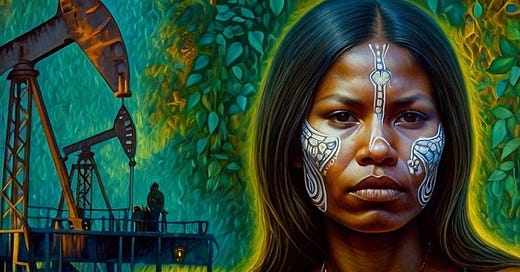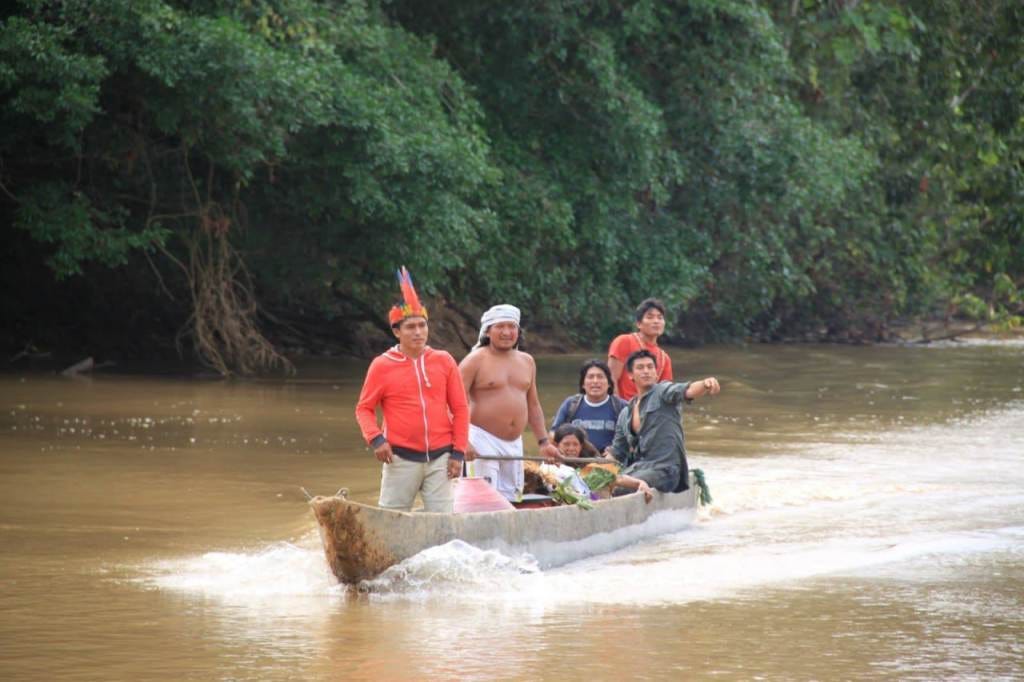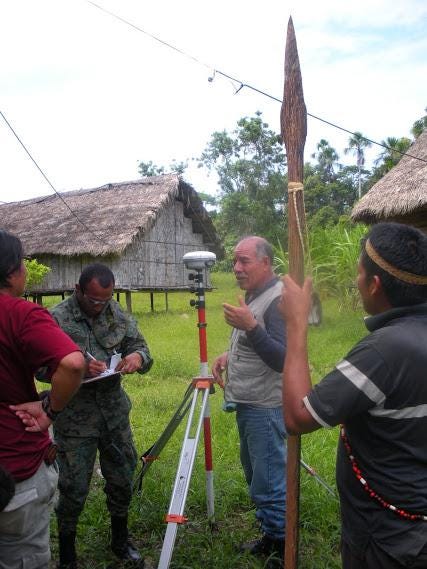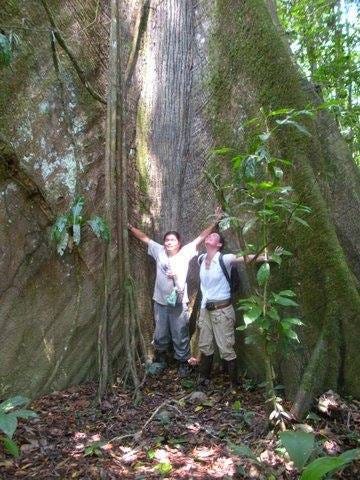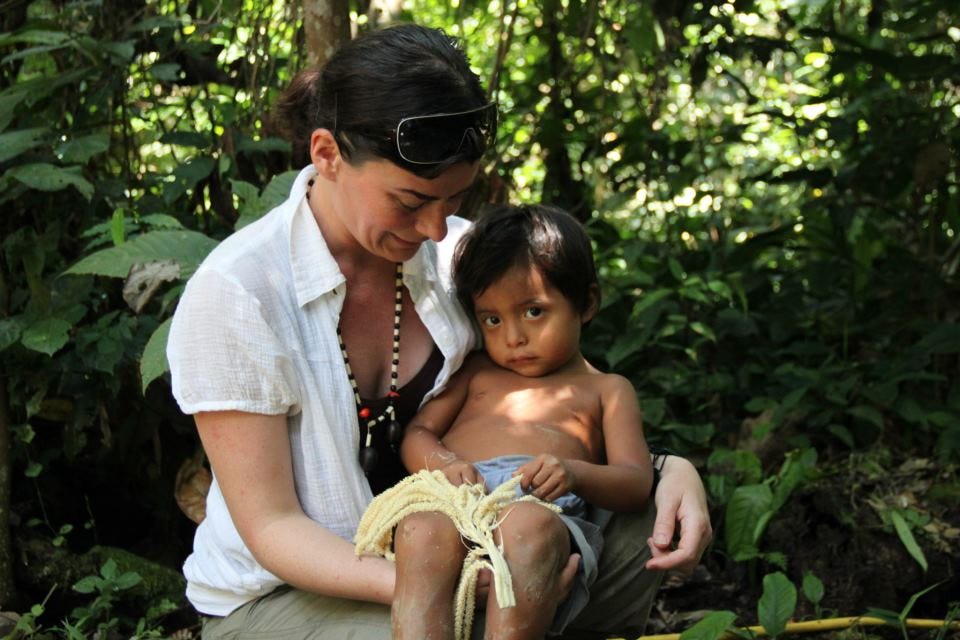Depiction of Ecuadorian girl and oil drilling on her territory, art copyright by author Carlita Shaw.
I recently received urgent news from my lifelong friends in the Shiwiar Amazon rainforest nation of Ecuador—their ancestral rainforest is once again under threat from oil drilling. This is particularly shocking given that just a year ago, the Ecuadorian government pledged to halt oil extraction in the Amazon following an 18-day national protest led by Indigenous communities. That hard-won victory is now being disregarded, much like many earlier broken promises from Ecuador’s leaders. This betrayal threatens to prolong the devastation for another five years or more, violating the spirit of a referendum meant to protect the Amazonian biodiversity and its people.
a Shiwiar community navigating the Amazon river, Ecuador 2012, by author.
Back in August 2012, I embarked on a journey deep into the Ecuadorian Amazon to meet the Shiwiar people, a community I had long dreamed of supporting. My history with the Shiwiar community goes back to since beginning my Wildlife Conservation degree in London, England in 2000, I had been in contact with them through Sarah Dixon, who was collaborating on a plant medicine project with them, they have always been working on pioneering projects to protect their rainforest territory. After years of planning, I finally made it to their Juintsa territory—a remote area only accessible by a small apache plane from Shell, a 1.5 hours flight over the Amazon rainforest or a seven-hour canoe ride along the Amazon River from the Peruvian border.
Read Ecocide in Ecuador
The Shiwiar welcomed us with warmth and generosity, sharing their rich traditions and deep knowledge of the land. The biodiversity of their homeland was astonishing—vibrant macaws flew overhead, monkeys leaped between branches, and giant ants busily worked below. At night, the sky lit up with stars while frogs filled the air with song.
However, the tranquility of my 2012 visit was shattered on the fourth day when an uninvited military helicopter abruptly landed in Juintsa on August 21st. My heart sank—I feared it meant petroleum exploration. The geo-surveying officers claimed they were only mapping the area, denying any link to oil drilling. But in truth, this marked the beginning of what has become an escalating threat to the Shiwiar people and the Ecuadorian Amazon.
Military mapping Shiwiar territory, Juintsa. August. 2012. Photo credit: Carlita Shaw
Upon returning to England, I received devastating news in October 2012. My Shiwiar friends informed me that President Rafael Correa had struck a deal with the Ministry of Hydrocarbons and PetroPeru to sell oil drilling rights covering 75,000 square kilometers of primary rainforest. It was the start of an even larger expansion of oil exploitation, which continues today despite fierce resistance from Indigenous communities. After his presidency, Correa fled with a portion of Ecuador’s funds, leaving his successor, Lenín Moreno, to handle the fallout of crippling national debt.
In 2014, I returned to Ecuador after a short stay in England and continued to work with indigenous rainforest communities for six years thereafter. In 2017, I was forced to leave Ecuador, when my life and my Ecuadorian husband’s life was threatened due to our work—tragically, it was also why I lost my husband six months following having to flee the country. The overwhelming beauty of the Amazon and my connection to it remain deeply embedded in my heart.
The 2023 Referendum
In August 2023, there was a glimmer of hope—a historic referendum followed the Indigenous protests. Nearly 60% of Ecuadorians voted to end oil drilling in Yasuni National Park, one of the most biodiverse regions on Earth. This vote was seen as a crucial step in reducing fossil fuel dependence, diversifying energy and fuel, while recognizing the Amazon’s vital role in its role in providing fresh water production and as a keystone ecosystem for carbon storage. Indigenous leaders and environmentalists believed it would stop Petroecuador’s operations in the Yasuni ’43-ITT’ oil block, leading to eventual ecosystem restoration. Read more here about this event
It is now just a year later, and oil extraction not only continues but oil reserve blocks such as block 86 on the Shiwiar’s territory are being earmarked for development.
Moreover, Petroecuador still pumps 58,000 barrels of oil a day from the same region as Yasuni national park , and the government has failed to uphold its commitments to the people of Ecuador and Indigenous communities, instead of being included are now being excluded from decision-making and have been increasingly betrayed.
“The machinery is still there—where’s the government’s commitment?” asks Nemonte Nenquimo, a leader of the Waorani people.
The 2008 Ecuadorian Constitution
Indigenous groups in Ecuador have been recognised under the United Nations with which there is a non-binding agreement, which gives them the opportunity to defend their lives, lands and culture. Throughout the Declaration, the right to a process of “Free, Prior and Informed Consent” is guaranteed for indigenous peoples when faced with decisions, projects or legislation by corporations or governments that may affect their people and/or territory. Article 57, paragraph 7 of the 2008 Ecuadorian Constitution guarantees free, prior and informed consultation, within a reasonable time; however, this does not require consent (and is not binding). Article 82 refers explicitly to environmental consultation, in the case of a state decision that may affect the environment and specifies broad and timely information for those affected.
While Ecuador’s Constitution mandates consultation with Indigenous groups on issues affecting their lands, these discussions have been superficial at best, if they have happened at all, in the case of the Shiwiar and other indigenous communities, they have been the last people to even be notified of this plan, they have not even been approached for a consultation about drilling on their territory.
In 2008, Ecuador also became the first country in the world to enshrine the “rights of nature” in its constitution.
This groundbreaking decision was recognized the inherent value and dignity of ecosystems, granting them legal rights to exist, flourish, and regenerate. However, these rights have been consistently ignored. International petitions like the 2014 Yasunidos referendum were undermined, and oil drilling in Yasuni continued. Correa’s 2013 promise to keep the oil in the ground in exchange for international compensation proved hollow—deals with China had already been signed.
The Rights of Nature in the Ecuadorian Constitution
The Ecuadorian Constitution (Articles 10 and 71-74) acknowledges the inalienable rights of nature, including:
The right to exist and maintain its cycles, structure, functions, and evolutionary processes
The right to be restored and remedied when harmed or damaged
The authority for people to petition on behalf of nature
Despite this, the Ecuadorian government continues to violate not only its own constitution, but also it ignores and violates indigenous people’s rights, the Rights of Nature and the referendum that happened a year ago, it seems Ecuador is destined for at least five more years of destructive oil drilling.
The Ecuadorian government also seems to have forgotten the treaty it signed for The Escazú Agreement, which was signed in 2018 by 12 countries including Ecuador, the first treaty in history that includes specific provisions to protect those who defend the environment, setting an example for the entire world. It represents a vital opportunity to establish accountability for human rights violations related to the environment.
“But the mere signing of the Treaty is not enough. The signatory countries must ratify it now without delay and take concrete measures to ensure that it lives up to its ambitious ideals and that decisions on the environment truly reflect the opinions, needs and rights of the people most affected. ” -Erika Guevara Rosas.
a Ceiba tree in the Shiwiar territory over several thousand years old, photo by author.
The Oil Blocks
This pattern of exploitation is not new. Ecuador’s oil history is marked by environmental devastation and violence, beginning in the 1940s with the invasion of Waorani territory. By the 1970s, oil pipelines crisscrossed the country, and Texaco-Chevron’s operations left behind toxic pollution that sparked ongoing health crises for Indigenous communities. Decades of legal battles have followed, but justice remains elusive, with rivers still contaminated and lands poisoned.
Map of Oil Blocks over the Ecuadorian Amazon Rainforest, Block 86 affects the Shiwiar Rainforest territory.
Oil exploitation in Ecuador is framed as ‘development,’ but in reality, it’s a desperate attempt to repay the nation’s staggering debt—$11 billion owed to China and $17.4 billion to the US. These financial pressures drive the relentless destruction of the Amazon, sacrificing both the environment and Indigenous peoples in pursuit of profit. Seven Indigenous nations—Kichwa, Sapara, Sarayaku, Shuar, Waorani, Shiwiar, Andoas, and Achuar—have already suffered profoundly, and now the Shiwiar face potential displacement as oil companies push deeper into their lands.
Block 86, which includes Shiwiar territory, is one of the many areas slated for drilling. In other regions, the military, working in coordination with oil companies, has forcibly removed Indigenous people from their ancestral rainforest territories for the oil beneath the soil. This gross human rights violation threatens to displace entire populations.
Aerial view of the Ecuadorian Amazon, photo by author.
Meanwhile, the world is hearing a critical situation is unfolding in Brazil with Amazon Rainforest deforestation and land-use changes, exacerbated to an alarming 104% increase in fire hotspots in the Brazilian Amazon rainforest region between January and August 2024. These reports collectively indicate that the areas affected by fires in the Brazilian Amazon in 2024 are substantial, with various estimates ranging from 5,010 square kilometers (deforestation) to 26,246 square kilometers (total fires in the first seven months) to 11,000 square kilometers (real-time satellite monitoring), compared to 2023.
Alarmingly, much of this is caused by human-induced fires, worsened by intensive deforestation which causes drought and increasingly flimsy laws that the Brazilian government do not care to follow. As a result huge areas in the Pantanal region, with 3,845 fires recorded between August 1 and 27, 2024, a 3,707% increased compared to the same period in 2023, all premeditated activities in preparation for oil, gold and mineral mining, soy production and beef cattle farming.
For these reasons now more than ever we need to be more stringent and resistant to these ecocidal scales of destruction that are unfolding across the entire Amazon basin, especially intensified activities across Brazil, Ecuador, Colombia and Peru, as it is not only causing devastating loss of biodiversity it is also creating the largest wave of Indigenous displacement in history. This is an urgent call on international countries and nations who are currently doing very little to intervene to stop the decimation of the last of the Amazon rainforest basin. The Amazon basin not only holds half the world’s biodiversity, it is also responsible for 20 percent of our oxygen and 20 percent of the Earth’s fresh water production.
Carlita with a Shiwiar boy named Oliver, Juintsa, 2012, photo by author.
The ongoing crisis in the Amazon requires more urgent global intervention of unfolding ecocide of the Amazon nations. We cannot allow this ecocide to continue unchecked. Ecuador’s government must be held accountable, and the international community must stand in solidarity with the Indigenous peoples who are fighting not only for their lands but for the future of our planet. The Amazon is not just a national treasure; it is critical to the health of the entire world. We must act to protect it, not just for the Shiwiar, but for all of humanity.
The fate of the Ecuadorian Amazon hangs in the balance, we must act now—before it’s too late.
We Need a Rights of Nature & Ecocide Lawyer to Help the Shiwiar Save the Rainforest
Check Out Our Biobank LandTrust Project
We have plans to build a Biological Research Station in the tree canopies
The Shiwiar Invite you to learn plant medicine and rainforest survival with comfortable accomodation for Rainforest Volunteers- if you would like to visit, contact me and we will arrange everything for you through my Shiwiar friends.
Learning Plant Medicine and Survival techniques in the Amazon Jungle with the Shiwiar
I was working with the Shiwiar tribe on a biodiversity project with French biologist Samuel Remerand and his amazing son, who filmed this video in the Ecuadorian Amazon in 2012. This was one of the most insightful and amazing experiences of my life; we lived with them for four weeks and learned how to survive, hunt and use medicinal plants. This video contains some highlights and inspired the writing of my book. Why deforestation is happening and what we can do to prevent it. This is an exclusive chance to volunteer with the Shiwiar, live in the Amazon rainforest with experienced and licensed guides, you will feel safe and they’re the most amazing hosts, if you would like to have an experience like this and live and learn from them deep in the Amazon, then message me and I will put you in touch with the Shiwiar chief.
by
Originally published 12th September, 2024 on my Evolve to Ecology News site
Supporting my work and buying a Ko-Fi, helps me have time to work on these projects and be a voice for the Shiwiar and the Amazon Rainforest. ( Sharing this article also helps immensely).
Help fund a Flight of Five of my Rescue Pets from Mexico to EU
Further reading
Evolve to Ecology articles
Ecuador Triumphs after 18 days of Strikes
The Escazu Agreement – environmental and human rights
Calling all Original Ancestral Land Guardians
Convocatoria a todos los Legítimos Propietarios Ancestrales Indígenas
Why Indigenous People are the Best Conservationists
Resurrecting the Secret Ancient Cities of the Amazon Rainforest
Celebrating Indigenous Land Rights: Landmark Victory in Brazil’s Supreme Court
Increasing loss of Indigenous lives and exponential loss of protection of the Brazilian Amazon
Ecuador Sold Out to the Highest Bidders
Illegal Gold Mining in the Amazon, destroying the Brazilian rainforest in just 7 months.
Deforestation and genocide in the Amazon reaches accelerated levels
The Brazilian President Jair Bolsonaro, Openly declared Genocide on the Kawahivas people who are on the edge of extinction
Increasing loss of Indigenous lives and exponential loss of protection of the Brazilian Amazon
The Environmental impact of China’s Twin Oceanic Railway on the Amazon & Indigenous People

